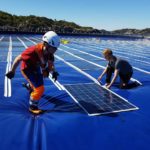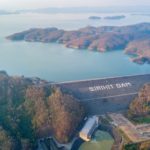Exciting new floating solar installations around the world, a ray of sunshine in the cloudy Pacific Northwest, and reservoir woes in Southern Oregon.
Yes—this is a wide range of topics. One of the most fascinating and challenging aspects of understanding the floating solar market is the technology’s unique positioning at the nexus of energy, water, and land management.
It means that all sorts of factors can drive floating solar adoption, whether that’s a mine or quarry being decommissioned, new restrictions on installing ground-mounted solar on farmland, rollout of new community solar rules in a territory, or even the pursuit of more knowledge about…floating solar.
South Africa
It’s official—commercial floating solar has arrived on the African continent.
South African renewable energy developer New Southern Energy recently completed a 60 kW floating solar system at the Marlenique Estate, a fruit farm and wedding venue near Franschhoek in South Africa. The floats came from Ciel & Terre, a leading global provider of floating solar hardware, and the system complements a much larger 534 kW ground-mounted system on land adjacent to the farm’s irrigation reservoir.
The project is a near-perfect case study for floating solar. Owner Carl van der Merwe originally looked into solar power due to frustrations with unreliable power supply from Eskom, one of Africa’s largest utilities. The farm plans to install a battery system in a second project phase to build a true microgrid, providing them with 100% energy independence. A stable power supply was crucial to the successful operation of the farm’s cold storage, irrigation, and wedding venue facilities.
Outside of securing a stable power supply, Marlenique Estate checked practically every box for potential floating solar benefits, confirming research conducted years prior in the region. They reduced evaporation on their reservoir while South Africa is still reeling from last year’s drought. They achieved higher photovoltaic panel productivity due to the cooling effect of the water. They slowed their growing operational expenses. They even created a space for fish to congregate.
Albania
Norwegian floating solar developer Ocean Sun recently sold a 2 MW floating solar system to Norwegian utility giant Statkraft for installation at the Banja reservoir in Albania, with help from a feed-in tariff authorized by the Albanian government.
The project boasts several of the typical benefits of floating solar systems—ease of installation, scalability, increased panel efficiency, reduced evaporation, algal bloom mitigation—but it’s a new type of floating solar in its own right.

While most floating solar arrays are mounted on hard high-quality plastic floats, connected together to form a semi-rigid unit, Ocean Sun’s technology installs dual-glass modules on a durable, thin, flexible membrane. This is Ocean Sun’s first sale, so the project will amount to somewhat of a pilot, but the added benefits are compelling.
According to Ocean Sun, direct panel contact with the water can boost efficiency by up to 15%, where more traditional floating solar arrays tend to claim 10% or less. The thin polymer membrane minimizes materials on the system, helping to lower cost and reduce the burden of plastic waste 20-30 years from now. Finally, the membrane structure is claimed to flex with ocean swells, making the system more durable, and their models show the system withstanding hurricane-force winds of 170 mph.
Floating solar is still an emerging technology, representing about 1% of installed solar capacity worldwide, and healthy competition among hardware manufacturers can only benefit offtakers.
Thailand
The state-run Electricity Generating Authority of Thailand (EGAT) just upped the ante in a serious way, committing to build a series of floating solar projects across its reservoirs totaling 2.7 GW in capacity. The project is nearly three times larger than total installed floating solar capacity today, globally. The largest project is slated to be a 325 MW array on the 100 square mile reservoir held up by the Sirikit Dam in Uttaradit Province, more than twice the size of the already-gargantuan, current-world’s-largest 150 MW array in Anhui Province, China.

The first project looks to be a 45 MW array at the Sirinhorn Dam, which will notably be comprised of proprietary floating solar hardware developed by Siam Cement Group, one of Southeast Asia’s leading manufacturers of construction materials. The project shows that despite the rapid success of global hardware leaders like Ciel & Terre and Sungrow, floating solar is still anybody’s market.
If the project goes as planned, it will bring Thailand’s energy portfolio from today’s 12% renewable to 37% renewable by 2036.
It Works
Technology moves quickly, and solar power is becoming increasingly viable even in cloudy regions like the Pacific Northwest.
Washington State just announced its first lease of public lands for a solar farm of any size, and they’ve eschewed pilot projects in favor of a full-blown utility-scale project. The farm, led by renewable energy titan Avangrid, will be good for 150 MW in Klickitat County.
It’s a major vote of confidence in the efficiency and cost-effectiveness of today’s photovoltaic technology, and spells opportunity for the region. Klickitat County isn’t as cloudy as coastal areas in the PNW, but it’s still cloudy about half the year, and is already served by ample hydropower and wind power resources. These factors have typically turned solar developers toward more favorable regions. Now, proximity to existing transmission infrastructure, and the proliferation of energy-intensive data centers in the area, helped the project pencil. It’s a new day for solar in the Northwest.
Where Does Floating Solar Come In?
Despite a host of renewable energy incentives sunsetting in the state in 2017, two major forces are converging that—with the viability demonstrated by Avangrid’s project in Washington—make Oregon a promising place to explore floating solar development.
The first was the passage of SB 1547, Oregon’s aggressive move to ditch coal-fired power plants, with its commencement of planning to roll out a statewide community solar program. The program will allow residents within the same utility territory to subscribe to local solar projects that don’t sit on their property, which overcomes a large barrier for residents with limited yard space and lots of tree cover. There are still key questions outstanding in the rules, most importantly the PUC’s determination of the Resource Value of Solar (RVOS) and the associated bill credit for community solar subscribers, but if the numbers land where we hope they will, the program will unleash rapid deployment of 160 MW of solar power across the state.
The other major development is a growing opposition to repurposing heritage vineyards and farmland for ground-mounted solar installations. Already Clackamas, Jackson, Marion, and Yamhill counties have taken decisive action to hinder ground-mounted solar development in their jurisdictions, helped by land use advocacy groups like 1000 Friends of Oregon. Most recently, there appear to be severe limitations to ground-mounted solar on farmland on a statewide basis coming down the pipe.
It’s hard to blame them, as repurposing large swaths of land can have plenty of negative environmental consequences, not to mention economic impacts to neighboring rural residents who aren’t cashing in on these solar projects, but we still hate to see different factions of environmentalism at odds with one another. It’s also a shame to see any hindrance to renewable energy development for any reason, given the UN IPCC’s horrifying recent report on climate change, and the proximity of Oregonian farmlands to power transmission lines.
This is where floating solar can offer a solution. Oregon has ample surface water in its rural areas, close to both potential offtakers and transmission lines, helping ease the costs of any floating solar installations. With a strong community solar program in place, pond owners could deploy systems of <3 MW, roughly enough to power 600 homes each, offering cost savings to people who really need it, and helping the Beaver State transition away from coal power once and for all.
Pumped Hydro in Oregon and Washington
In other parts of the region, tensions are brewing around six separate pumped hydroelectric storage projects in various stages of feasibility analysis and Federal Energy Regulatory Commission (FERC) approval. Pumped hydroelectric storage, or “pumped hydro,” is an innovative approach to solving the “duck curve” problem with renewable energy. The duck curve is a phenomenon wherein solar energy is at maximum production during midday, then drops sharply upon sundown, forcing other power sources to rapidly ramp up to meet demand. Managing against the duck curve is often expensive and challenging for power providers. You can read more in this factsheet from the California Independent System Operation Corporation.
Pumped hydro offers an elegant solution to the problem. Pumped hydro systems involve two reservoirs—one at a significantly higher altitude than the other—connected by a pipe containing one or more reversible pump-turbine/motor-generator assemblies. The system pumps water into the uphill reservoir during low demand periods when energy prices are lower, then allows the water to flow back downhill during peak demand periods when energy is most expensive, playing a form of energy arbitrage. They address the duck curve problem by rapidly ramping up energy production at a significant scale as the sun sets, replacing the power that solar panels provided during the day. The Energy Storage Association offers further reading, including alternate configurations of pumped hydro systems.
Pumped hydro technology is crucially important to American energy infrastructure, with projects built from the 1960s through the 1980s representing over 90% of energy storage capacity in the United States. Their purpose was to boost the profitability of nuclear power plants, that—like solar power—cannot easily adjust production to shifting demand (nuclear plants are most efficient when they run at a steady rate, so unlike solar, the plants use pumped hydro to bank power overnight instead of during the middle of the day). We stopped building pumped hydro systems as our focus on nuclear power development waned a few decades ago, but the rise of solar and wind power has fueled renewed interest in the technology.
Developing massive infrastructure like pumped hydro, however, poses significant challenges. Navigating regulatory frameworks across jurisdictions can take a decade or more, as experienced by the developers of six pumped hydro projects pending in the Pacific Northwest. Perhaps the largest challenge is managing negative impact to local stakeholders, who care less that pumped hydro is a well-established and cost-effective way to store energy, and care more about having their land and water impacted by massive construction projects nearby.
Rye Development, a firm that is front-and-center about “low impact” pumped hydro projects and their commitment to environment and local community interests, is developing one such project in Southern Oregon. At 393.3 MW, the project is an utter behemoth, with capacity to meet the demand of 290,000 to 390,000 homes when the water is flowing downhill. It’s not nearly the largest of the six projects proposed in the Pacific Northwest either, and will likely only represent about 5% of projected energy storage needs in Oregon and Washington by 2035. As critically necessary as these types of projects are, this one has been deeply polarizing to the local community.
On the one hand, the project is likely to bring revenue and jobs to Klamath County, which operates at a $2 million annual deficit and is in sore need of the support. On the other hand, constructing two brand-new 60-acre reservoirs and many miles of transmission lines is deeply disruptive to homeowners and tribal lands in the area. Homeowners will see their bucolic views (and associated tourism revenue) impacted, potentially deal with irritating noise, see bird populations impacted, see a massive draw on local groundwater, and have to reroute crops and irrigation lines to adjust. They’re also worried about wildfires, which is understandable given the unimaginable recent fires that clobbered Malibu and Santa Rosa in California, wiped the town of Paradise, CA off the map, and desecrated the Columbia River Gorge, one of Oregon’s most beloved recreational gems.
Burying the power lines would address many of these issues, but it would drive up the cost of transmission by about 1500%. It’s also not going to happen. The U.S. Federal Energy Regulatory Commission awarded a 50-year license for the project earlier this month, meaning that homeowners who don’t agree to settlement terms will be forced to endure the eminent domain process.
Sustainable development, done right, seeks to make use of existing resources wherever possible. The relative benefits of floating solar power depend heavily on this principle (i.e. not repurposing valuable land). We would be happy to see new pumped hydro projects sited at existing reservoirs, which already have many of the hardest questions answered—abundant water, uphill, connected to the grid via existing high-voltage transmission lines. Constructing a lower-elevation reservoir to complete the picture would be far less impactful than the project underway in Klamath County. The approach would help locals feel much better about their contribution to our collective interests as residents of this planet, and would likely make for a much easier permitting process.
So what does all of this have to do with floating solar? Beyond the obvious benefits of siting solar panels on the massive quantity of surface area found in our reservoirs, there is a powerful synergy between floating solar and pumped hydroelectric. The Lapeenranta University of Technology in Finland published a study last year (free download) analyzing the impact that floating solar could have on pumped hydro systems, which represent 141 GW of pumped hydro capacity globally. That’s good for about a hundred million homes’ worth of power.
The numbers are staggering. Covering 25% of the surface of those pumped hydro reservoirs is likely to result in a 5.22x increase in their power production capacity, which is huge—pumped hydro systems are efficient storage systems but still experience losses, and floating solar would turn them from net energy consumers into net energy producers. Here in the United States, which boasts a relatively small 2.58 GW of pumped hydro capacity, covering 25% of the 312 square miles’ worth of associated surface water would produce 13.4 GW of floating solar production (enough to power the entirety of New York City’s five boroughs) and prevent 183,000 acre-feet of evaporation annually (enough water to serve a third of the City of Los Angeles), which in turn provides more water for traditional hydropower and storage capacity. Taken globally, the impact would be more than 50 times larger.
That’s just for pumped hydro storage reservoirs, and doesn’t even consider other types of man-made reservoirs, of which our country boasts nearly 25,000. The implications are clear—every pumped hydro system should install floating solar power.
Groups are already starting to put this exciting theory into practice. Leading global floating solar developer and hardware manufacturer Ciel et Terre partnered with Portugal-based global energy developer EDP to build a 220 kW floating solar pilot project on Portugal’s Alto Rabagão Dam. The pilot went live in 2016. The floating solar panels represent less than 1% of the dam’s nameplate capacity, but importantly, it demonstrated that these systems can work in practice, even when facing a constant water level variation of nearly 100 feet. Thanks to the massive potential for the synergy between floating solar and pumped hydro, the success of this pilot is likely to catalyze many more projects in Portugal and beyond. It’s not a moment too soon.
Originally Published: https://splash.solar/floating-solar-news-spring-2019/
 On a scale of 1 to 10 for the complexity and divisiveness of issues, Jordan Cove is off the charts. The project, a proposed pipeline between Malin in Klamath County eastern Oregon and Coos Bay on the coast, would pump liquefied natural gas (LNG) to be exported at the International Port of Coos Bay. The pipeline would be a continuation of the Ruby pipeline that stretches from Malin out to Opal, Wyoming which currently serves the natural gas needs of California, Nevada and the Pacific Northwest.
On a scale of 1 to 10 for the complexity and divisiveness of issues, Jordan Cove is off the charts. The project, a proposed pipeline between Malin in Klamath County eastern Oregon and Coos Bay on the coast, would pump liquefied natural gas (LNG) to be exported at the International Port of Coos Bay. The pipeline would be a continuation of the Ruby pipeline that stretches from Malin out to Opal, Wyoming which currently serves the natural gas needs of California, Nevada and the Pacific Northwest.
 Our jails are a reflection of our national character and who we are as a society. There is much to be critical about when it comes to the United States holding more than
Our jails are a reflection of our national character and who we are as a society. There is much to be critical about when it comes to the United States holding more than 





